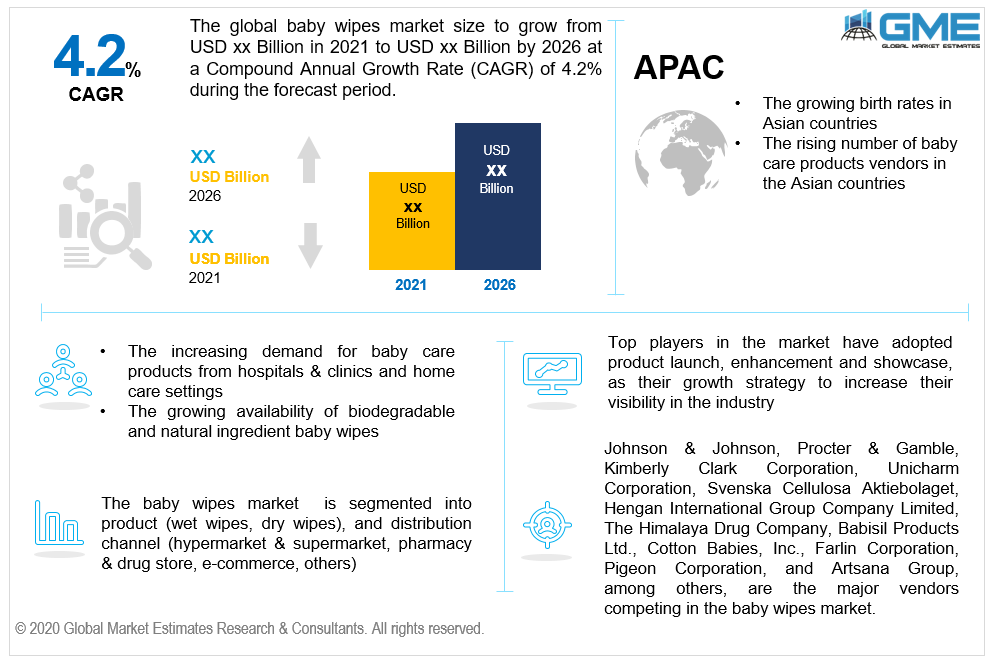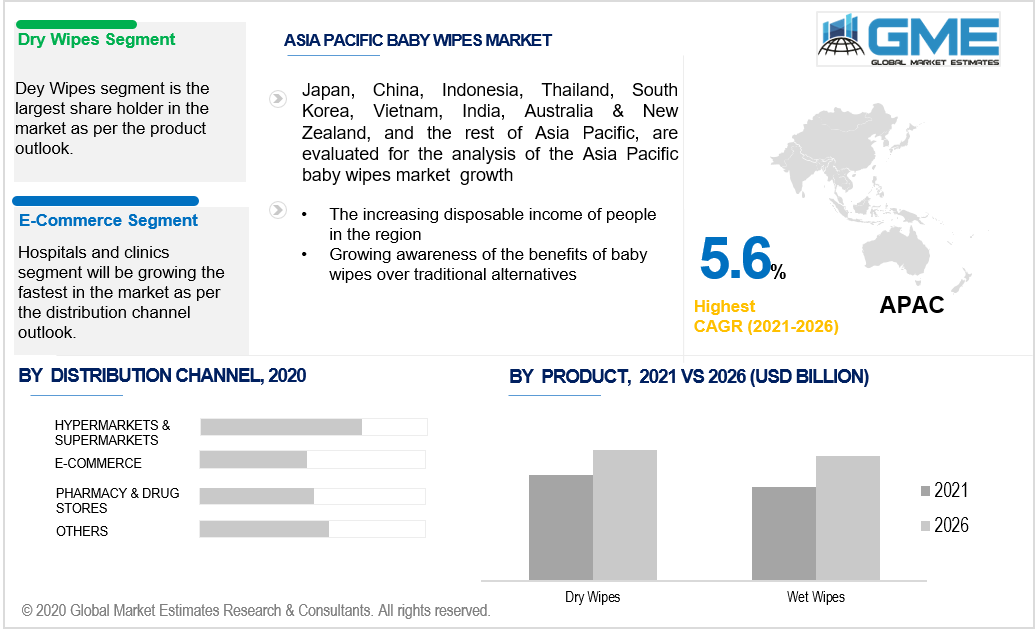
Global Baby Wipes Market Size, Trends, and Analysis- Forecasts To 2026 By Product (Wet Wipes, and Dry Wipes), By Distribution Channel (Hypermarket & Supermarket, Pharmacy & Drug Store, E-Commerce, Others), By Region (North America, Asia Pacific, CSA, Europe, and the Middle East and Africa); End-User Landscape, Company Market Share Analysis & Competitor Analysis
Baby wipes are used to clean and dry the sensitive skin of infants and children. Baby wipes rose to prominence as transportation grew and people became more inclined towards travel and tourism. They needed a way to clean infants and children on the go when they are without access to water. Baby wipes come in two forms, wet wipes, and dry wipes. Baby wipes are medium-sized pieces of soft plastic or cloth, wet wipes come pre dipped or saturated in gentle-to-the-skin cleaning solutions. In recent years, consumer preferences have shifted towards eco-friendly and biodegradable baby wipes which are free of synthetic fragrances, artificial colors, harsh to the skin chemicals. There has been an increased effort on the manufacturers end to create baby wipes that use natural ingredients like aloe vera, chamomile, and calendula extracts which are gentle and soothing to the skin of newborn infants and keeps the skin nourished. The baby wipes market has been driven by the increasing expenditure on baby care products. Growing income per capita income of parents and the increasing participation of women in the workplace have also contributed to the growth of the baby wipes market. Growing per capita income has increased the disposal income of parents which has increased their spending on quality baby care products. Baby wipes allow parents to prevent rashes and irritation of the skin and help prevent bacterial infections, allergies, and other issues. Baby wipes help to clean and reduce the bacterial growth on the skin and avoid infection and skin irritation in babies. The baby wipes market is also driven by the multifunctionality of these wipes and can be used by adults as well. During the COVID-19 pandemic, sanitation and hygiene were of utmost importance which had often left sanitation products unavailable which lead to people using baby wipes as a more readily available option and at times cheaper than regular products. Growing awareness among parents for biodegradable and natural ingredients has caused a shift in the preference of parents towards green and biodegradable baby wipes. Companies have begun releasing new lines of green, biodegradable, and all-natural baby wipes. The growing birth rate in developing nations and the increasing disposable income have also increased the demand for baby wipes. The market is restrained by the growing number of counterfeit products made of synthetic materials, increasing demand for biodegradable and green wipes. The low shelf of wet wipes due to the drying of solutions and the need to be consumed entirely before they dry out is another restrain to the growth of the baby wipes market.

Based on the product, the baby wipes market can be segmented into wet and dry wipes. The dry wipes segment will hold the major share as compared to the wet wipes segment of the market. This is because dry wipes have a larger range of applications. They can be used as tissues, toilet papers, and towel substitutes. They have a huge range of applications as compared to wet wipes. Dry wipes can be used during feeding, cleaning, and other general uses due to the high absorbability of dry baby wipes. Dry wipes also have a longer shelf life and can be used more slowly than wet wipes. Wet wipes are prone to drying up and have a smaller shelf life and have to be used in their entirety before the solution dries up.
Based on the distribution channel, the baby wipes market can be segmented into hypermarket & supermarket, pharmacy & drug store, e-commerce, and others. The hypermarket and supermarket segment will be the top consumer segment of the market during the forecast period. Hypermarkets and supermarkets carry a wide range of products ranging from hygiene products, food items, electronics, and other items. This allows consumers to purchase baby wipes along with their regular shopping needs. Hypermarkets and supermarkets often offer discounts on bulk purchases and other promotions. The e-commerce segment will have the highest value of CAGR among all segments during the forecast period. E-commerce is rapidly growing mainly because people find it more convenient to purchase items online. The added benefits of additional discounts when purchasing from online stores are also expected to increase their share of the baby wipes market.

The North American region will be on the top of the list in terms of revenue sale generation in the market. This region has a high per capita income and a large number of working women and single mothers which has led to the dominance of the region. The consumers in the region are also more aware of the benefits of using baby wipes and a lack of other alternatives have resulted in the dominant share of the region in the baby wipes market. The increased mobility of people in the region has also played a crucial role in the demand for baby wipes in the region as baby wipes can be used on the go. The APAC region will grow faster than Europe, NA, MEA, and CSA. The increasing birth rates in the region have increased the demand for baby care products in the region. The growing economic conditions and per capita income in the region are expected to increase the demand for baby care products owing to the increased availability of disposable income.
Procter & Gamble, Johnson & Johnson, Kimberly Clark Corporation, Svenska Cellulosa Aktiebolaget, Unicharm Corporation, Hengan International Group Company Limited, Babisil Products Ltd., The Himalaya Drug Company, Cotton Babies, Inc., Pigeon Corporation, Farlin Corporation, and Artsana Group, among others, are the major vendors competing in the baby wipes market.
Please note: This is not an exhaustive list of companies profiled in the report.
We value your investment and offer free customization with every report to fulfil your exact research needs.
The Global Baby Wipes Market has been studied from the year 2019 till 2026. However, the CAGR provided in the report is from the year 2021 to 2026. The research methodology involved three stages: Desk research, Primary research, and Analysis & Output from the entire research process.

The desk research involved a robust background study which meant referring to paid and unpaid databases to understand the market dynamics; mapping contracts from press releases; identifying the key players in the market, studying their product portfolio, competition level, annual reports/SEC filings & investor presentations; and learning the demand and supply-side analysis for the Baby Wipes Market.

The primary research activity included telephonic conversations with more than 50 tier 1 industry consultants, distributors, and end-use product manufacturers.

Finally, based on the above thorough research process, an in-depth analysis was carried out considering the following aspects: market attractiveness, current & future market trends, market share analysis, SWOT analysis of the company and customer analytics.

Tailor made solutions just for you
80% of our clients seek made-to-order reports. How do you want us to tailor yours?
OUR CLIENTS